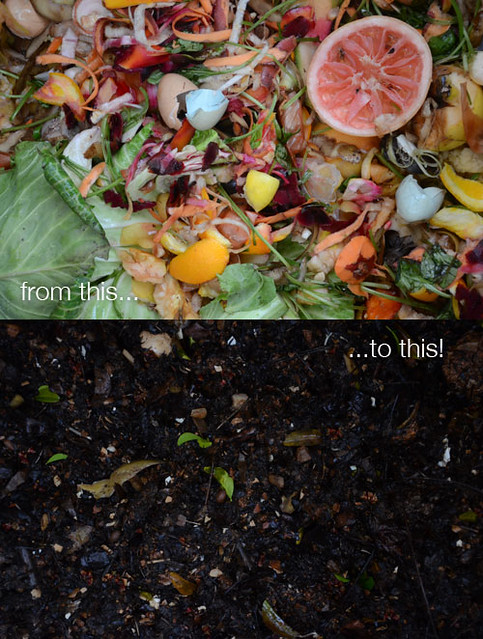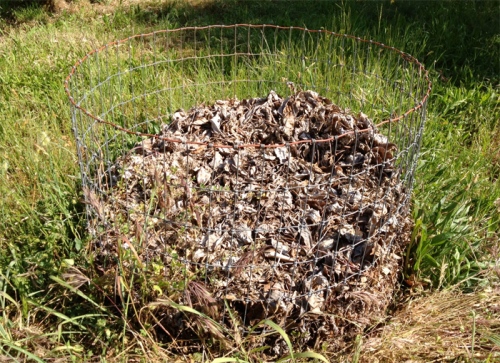 My goodness, I can?t believe I missed writing something for International Compost Awareness Week! (Yes, it most certainly is a real thing!)
My goodness, I can?t believe I missed writing something for International Compost Awareness Week! (Yes, it most certainly is a real thing!)
When I took the UC Master Gardener training last year, we spent quite a lot of time on compost for the ?Master Composter? element of certification. (After the first day, I couldn?t wait to get home and start turning my rather neglected compost heap ? it was seriously that inspiring.)
As Master Composters, we?re honour-bound to talk up the joys of decomposition and organic nutrients at every available opportunity? and so, of course, it was only a matter of time for me to do so here! (Oh, and don?t miss our Homestead Radio Hour interview with Kevin ?The Worm Whisperer? Marini, UC Extension expert, at the end of this post? talk about inspiring! His contagious enthusiasm will have you marching out to the yard, pitchfork in hand.)
If you don?t already have a compost pile, by all means, let?s do something about that right away! It really is very simple: all you need is a bit of outdoor space. If that isn?t an option, you can even compost indoors with a worm bin (see below). No excuses, right? Compost piles and bins take many forms, from the very basic heap to elaborately-engineered multiple bins and rotating tumblers; don?t be intimidated by all the fancy and expensive equipment proffered by garden catalogues and home-improvement stores. Start with something simple ? if you outgrow it, or you find that composting is really your ?thing,? you can always upgrade later.
Glamour shot of my beloved compost pile:

So, let?s begin at the beginning?
What do you need to make compost?
There are four key ingredients:
? Organic matter ? we need a balance of Carbon and Nitrogen to make really great nutrient-rich compost
? Air / Oxygen ? necessary for decomposition. If the pile goes anaerobic ? without air ? you?ll end up with a slimy, stinky mess. Good aeration makes for a happy, odor-free compost pile.
? Water / Moisture ? for much of the year, adding kitchen scraps and yard waste regularly will contribute enough moisture to your pile. In summer, however, you may need to water it occasionally. If you dig around and the pile looks dry or dusty, add water slowly so that it can soak in.
? Micro- and macro-organisms ? you can buy all kinds of magical compost-starting elixirs, but there is no need ? these friendly critters will move in on their own! Earthworms, fungi, bacteria, and other decomposers are key to a healthy compost pile.
If all these factors are present then compost will ?happen? all by itself, but for the best (and neatest) results, you will need a compost bin or designated ?pile? area with adequate ventilation and, ideally, a size of 27 to 125 cubic feet (3x3x3 feet to 5x5x5 feet). You will need to gather green (nitrogenous) and brown (carbonaceous) organic material, mix them in your bin or pile, and moisten the mixture if necessary. Mix and turn the pile each week, checking for moisture and adding water if it is too dry.
A couple of tried-and-true designs for backyard composting:
Movable compost pen

Advantages: simple and inexpensive to make; requires few tools and materials; can be moved easily to a different location or disassembled when the compost is finished to allow for easy spreading in the garden; you can build it to whatever size you like.
Disadvantages: Not as sturdy as permanent bins; in order to turn the compost you will need to ?dump? the bin and then refill it; if you are cutting wire fencing to height, it?s a good idea to cover or file down the pointy ends of the wires, especially if children or pets will be playing around the bin.
We use these moveable ?pens? out in the orchard to compost leaves and larger volumes of garden/yard waste. They?re perfect if you have a large quantity of material at once (think raking the lawn in autumn) and aren?t in a hurry to make compost. Turning your pile speeds up the decomposition process, but this is a good lazy, low-maintenance way to get the job done, and the fence ring keeps everything nice and neat (no windstorms/dogs/chickens spreading your leaf pile all over the yard!) If you set up the pen where you want the compost to eventually end up ? i.e. in your vegetable garden ? you can simply remove the ring and spread the finished compost when it?s done.
Multi-bin system

Advantages: Allows for fast composting, easy turning, and you can keep adding new, fresh material to the first bin without contaminating the ?cooking? or finished compost in the other bin(s). Sturdy and high-capacity. Easy to add a lid to if pests or nosy neighbours are a problem.
Disadvantages: more complicated and expensive to build than simpler bins; more tools and materials needed for construction; takes up more yard space.
We have a two-bin composting system that we adapted from a salvaged bin of uncertain provenance. (It used to have an astro-turf ?roof? on top ? go figure.) Multi-bin systems can be built out of pallets, scrap lumber, shipping crates, etc, or purchased ready-made. Our two-bin setup works nicely; fresh material goes in the left-side bin. When that fills up, I transfer it to the right-side bin to finish composting, and we start filling up the left bin again. Both sides get turned regularly. Really serious composters often use three-bin systems, in which the ?rough? compost goes into a middle bin before moving on to the final ?finished? bin. The triple-bin would be more necessary if you?re processing a large volume of material, or if you want to store your finished compost for a while.
 Some Common Composting Questions
Some Common Composting Questions
??I tried composting, but my pile always smelled bad and attracted flies.?
Flies can actually be beneficial to the composting process, but you can help keep them from becoming a nuisance by turning your compost pile more frequently to make sure that all parts of the pile ?cook? evenly. This will reduce the larvae population, as well as keep odor problems at bay. Food scraps are attractive to flies, especially fatty foods or meat scraps, which should not be put in the pile. Plant-based food scraps, eggshells, etc, should be buried or covered with straw or leaves to deter flies; this will also reduce odors. To keep pests and odors to a minimum, make sure your compost pile is in the recommended size range (from 3x3x3 for a bin to 5x5x5 feet for a heap) so that it generates enough heat to compost quickly and efficiently.
?Why should I compost when I can send my green waste away to be composted elsewhere??
Why pay to have your green waste taken away, and then spend more money on fertilizer, soil, and amendments for your garden, when you can make your own for free? Composting lets you recycle your kitchen scraps and yard waste into a valuable soil amendment and conditioner that you can then use in your own garden, yard, or potted plants. And unlike purchased soil additives and fertilizers, you know exactly what went into your compost ? no toxic gunk or weird chemicals to worry about. From an ecological point of view, composting your own green waste instead of having it hauled away conserves fossil fuels, energy, and money; instead of huge trucks and tractors, all you need is a simple backyard bin, a shovel or pitchfork, and a bit of your time. It?s easy, inexpensive, and environmentally friendly, and nothing beats the satisfaction of turning your scraps and yard waste into something you can use in your own backyard!
?What?s the difference between mulch and compost? ?
Mulch is applied as a top dressing around plants to conserve soil moisture, suppress weeds, keep the soil temperature cooler in hot weather, and reduce soil erosion and compaction. Mulch usually consists of non-composted, undecayed material ? wood chips, bark, grass clippings and leaves can be used, although compost may be used as a top dressing as well.
Compost is organic matter that has been decayed and decomposed with the help of bacteria, fungi, and other micro-organisms, as well as macro-organisms such as worms, nematodes, and insects. It generally contains a variety of basic nutrients and is used as a soil conditioner to improve soil quality. When mixed into soil, compost improves soil structure, holds nutrients in the soil and makes them more readily available to plants, improves drainage and aeration, and encourages beneficial organism populations.
?What about worm composting? Aren?t worms kind of gross??
Worm composting is ideal for when a small-scale indoor (yes, indoor!) composting system is needed, i.e. for apartment dwellers or those with small yards or limited mobility. It can also be a fun way to observe the composting process up close! You don?t need a high volume of organic material to stock a worm bin, it is tidy and odorless, and worm castings are a fantastic high-quality soil amendment.
For the worm-squeamish folks? first of all, to allay a common fear, worms don?t have teeth. They?re totally harmless, and not slimy at all. Really, though ?? you don?t need to handle the worms; they are generally content to stay hidden in their shredded-paper bedding. They are easy to take care of, too: the worms are not at all ?stinky? or ?yucky,? and you can feed them on your schedule ? once a day to once a week.
Eisenia foetida, the worm-composting worm, is different from your backyard-variety earthworm: they?re leaf-litter-dwellers, so they need a layer of shredded newspaper or the like to live in. They also need a dark bin with good aeration and just enough moisture. Store-bought worm bins can be pricey, but you can easily make your own from a plastic storage bin; check out instructions here. Just make sure that the bin is large enough, not too deep, and ? most importantly ? that it is opaque plastic, not clear. Worms will be much happier in a dark environment.
For more information on composting, be sure to visit the excellent Placer County Master Gardeners Composting Information page. You?ll find plenty of links to various bin plans, methods, and some fascinating info on all the critters living in your compost!

The Homestead Radio Hour
Composting with Kevin Marini, September 2011
With hosts Phyllis and Julia Boorinakis-Harper

Have more leaves in your backyard than you know what to do with? Maybe you?ve tried making a compost pile, but found it too stinky or too slow? Then you?ve come to the right place! On this episode of the HRH: UC Extension expert Kevin Marini, ?The Worm Whisperer,? discusses the hows and whys of traditional composting, vermicomposting, and more. Get the dirt on putting your kitchen scraps and yard waste to work, making your own homegrown, nutrient-rich soil amendments. From choosing a composting method to building a bin and maintaining your pile, Kevin explains how to make composting an integral part of your homestead (and maybe even your life!)
Click the ?play? arrow below to listen, or visit the KVMR Podcasts page here.
Like this:
Be the first to like this post.
ipo jim rome ufc on fox 2 weigh ins brandi glanville convulsions john tyler chuck
কোন মন্তব্য নেই:
একটি মন্তব্য পোস্ট করুন